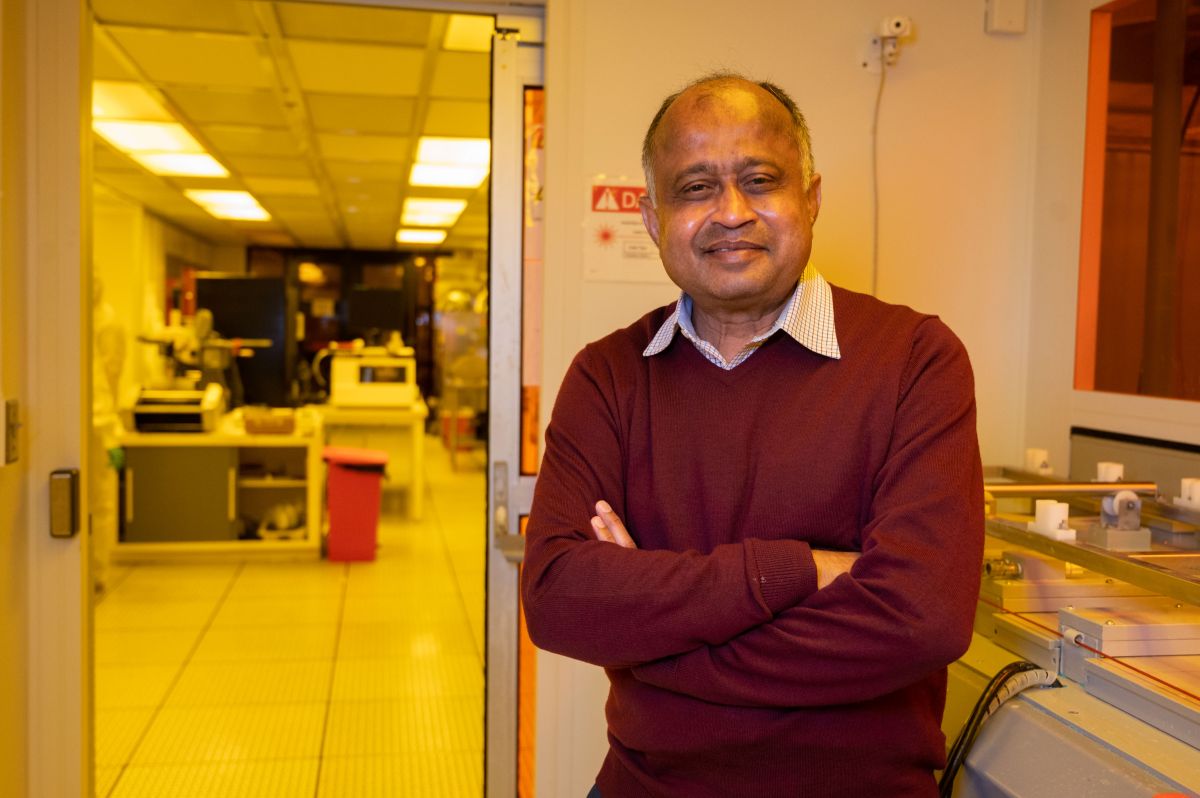By Stephanie Kalina-Metzger

Photo: Provided.
All it took for Madhavan Swaminathan was a little encouragement to jumpstart his career in innovation. The new head of the Department of Electrical Engineering in Penn State’s School of Electrical Engineering and Computer Science comes to Penn State by way of Georgia Tech, where he spent 28 years leading the 3D Systems Packaging Research Center and the National Science Foundation Center for Advanced Electronics through Machine Learning.
Swaminathan, who was born in India, said that innovation wasn’t really encouraged when he was young, but that all changed when he came to the United States, earned a Ph.D. in electrical engineering from Syracuse University and joined IBM.
“At that time, IBM was investing in the next supercomputers, when I was asked to develop new packaging technologies and my manager told me to concentrate on developing innovative solutions in that area,” said Swaminathan.
For those who might conjure up the idea of boxes and bubble wrap when it comes to packaging, Swaminathan explains that the packaging he speaks of is an entirely different concept. “If you view any electronic system, it has two parts. The first part are the transistors within a chip and the second part is the packaging. The transistors within the chip act as the brain and then there’s everything around the chip that supports its function, similar to the human body,” he said.
Swaminathan goes on to explain how minute these transistors are. “There can be one billion transistors within a chip and those transistors have to communicate within the external world and with other chips as well. To reduce the size of the system, you have to work on new packaging technologies,” he said, adding that packaging is very important in 5G and 6G communications and computers, where efficiency and battery life are important to send the electrons back and forth between chips.
“Students these days are very different. They are very much interested in startups and commercializing ideas, but college faculty members don’t always have an eye towards business. You need to have both sides and I intend to meet with faculty to encourage them towards providing a holistic education focused not only on research, but also on marketing and business.”
Being given the green light to begin innovating at IBM was a boon for Swaminathan and he took to the task with enthusiasm. From 1991 to 1994, while working there, he registered six patents related to advanced packaging.
Later, during a 28-year career at Georgia Tech as the John Pippin Chair in Microsystems Packaging and Electromagnetics at the School of Electrical and Computer Engineering, he developed 25 additional patents, mainly related to advanced packaging and heterogeneous integration of semiconductors.
“At Georgia Tech, we were studying new technologies for packaging and were licensed to create companies,” said Swaminathan, adding that Jacket Micro Devices was just one of those companies that began under his purview and was later acquired by a larger company.
Throughout all of these achievements, what excites Swaminathan most, he said, is living between the worlds of innovation and commercialization. “Being able to commercialize that which emerges from leading-edge research is a very important component, otherwise these great ideas can get lost,” he said.
A Penn State recruit
Swaminathan said that he wasn’t actively seeking a job when Penn State came calling. “I was actually very happy where I was at the time, but I was encouraged to apply via a search firm, so I did.”
“I can’t see any reason why Happy Valley can’t one day be known as Happy Silicon Valley.”
Swaminathan explains that he made it through the first round and a final interview before the Dean contacted him and asked him what it would take to convince him to relocate to Happy Valley.
“Continuing my research was very important to me and what struck me about Penn State were the people. I connected with them and their dedication to cutting-edge research was truly outstanding, which is why I thought, why not?” he said.
Swaminathan brings with him to Penn State a large packaging research center, which will include 13 other universities and which he will continue to lead, paving a path for his students.
“Students these days are very different. They are very much interested in startups and commercializing ideas, but college faculty members don’t always have an eye towards business. You need to have both sides and I intend to meet with faculty to encourage them towards providing a holistic education focused not only on research, but also on marketing and business,” he said.
“Being able to commercialize that which emerges from leading-edge research is a very important component, otherwise these great ideas can get lost.”
The reason Swaminathan cites commercialization as high on his list of priorities is because of the challenges faced within the United States.
“Whatever is done in the lab needs to translate into manufacturing. Right now, there are two challenges. [The first is] reshoring. Currently most manufacturing in semi-conductors happens outside of the United States. That needs to come back. Also, there’s the supply chain problem. The U.S. produces only 12% of chips here, while consuming more than 50%,” he said.
Swaminathan said that he’s looking forward to living and innovating in Happy Valley and is optimistic about the future.
“I can’t see any reason why Happy Valley can’t one day be known as Happy Silicon Valley,” he said with a smile.






